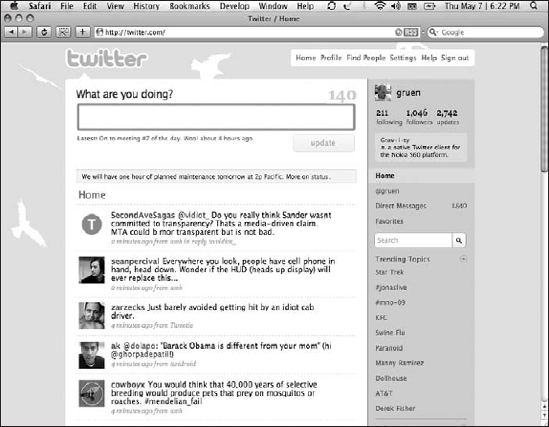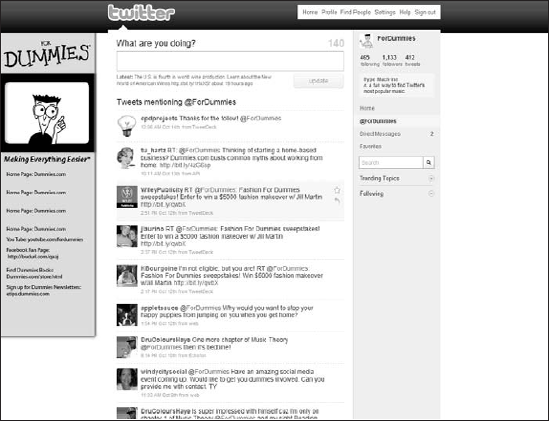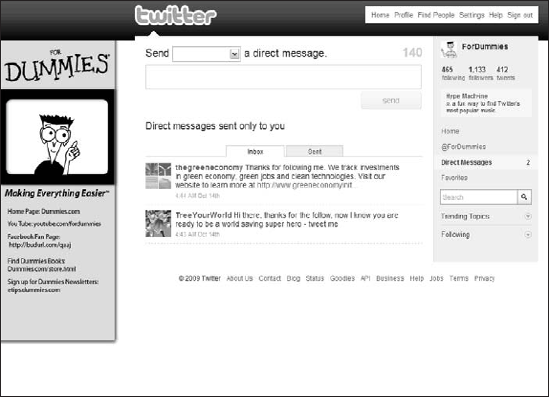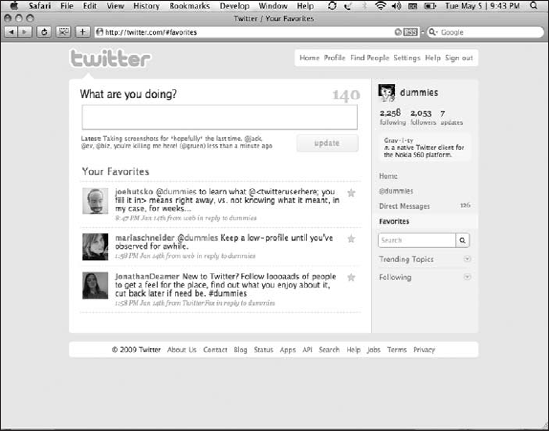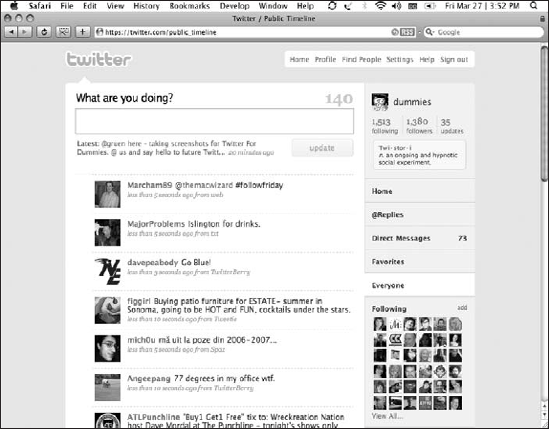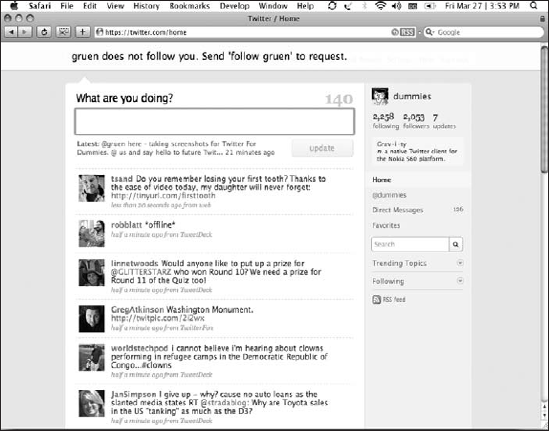Reading the feed on your Twitter Home screen
Making a Twitter conversation personal by using @replies and direct messages
Marking your Twitter favorites
Viewing who you're following and who's following you
Reviewing your past Twitter updates
For the power it wields, Twitter is one of the simplest and, we think, most elegant Web sites for mass communication. The interface makes interacting with other people — some you already know and others you'll meet — incredibly easy, and it cleanly organizes a lot of information.
As you use Twitter more and more, you may want to know where to locate things quickly and manage your communication flow more intelligently. In this chapter, we dive down into each Twitter page view, showing how it relates to the conversations going on around you and the conversations you're having directly.
When you first log into Twitter, the Home screen is your first stop. After you set up your account, you go to this screen to touch base with your followers and the people you're following. On the Home screen, you can also see who's talking to you directly through @replies, which are public tweets in response to individual users, and direct messages (DMs), which are private, one-to-one tweets. (For more on using @replies and DMs, see the sections "Tweeting to One Specific Person: @Replies" and "Shhh! Sending Private Notes via Direct Messages," later in this chapter.)
Additionally, the controls along the top of the Home screen let you change your settings, update your profile background, upload your avatar, toggle your SMS notifications, and more. (Chapter 2 covers most of these setup features.)
The Home screen, shown in Figure 3-1, has a standard layout. The header has a Twitter logo on the left and a list of links on the right, which appears on all Twitter pages. Those links' names describe where they take you:
Home: Your Home screen. Clicking on the Twitter logo at left also takes you to your Home screen.
Profile: Your Profile page.
Find People: The people search tool.
Settings: Where you can configure your Twitter account (see Chapter 2).
Help: FAQs and support.
Sign Out: Exactly what you think it is — signing out of your Twitter account.
Note
Twitter is a living Web application. Its interface changes from time to time, so if you can't find something immediately, it's likely taken on a different name or moved to a different location on the interface. For up-to-date information about what's going on with Twitter, visit the company's blog (http://blog.twitter.com).
The area on the right side of most Twitter.com screens (Home, Profile, Replies) is called the sidebar. It's both a reference for what you're looking at in the main content area and a controller for the Web site, and it's configured a little differently in each view. Here's a breakdown of what's on the sidebar. Except where noted, this description applies to the sidebar on your Home screen:
Your information: Your avatar picture and username. When you're logged in to Twitter and on your Home screen, you'll see only your avatar and username. Your Name, Location, Web, or Bio appear only on your Profile page. Click your avatar, the Profile link, or any
@usernamelink for your name to see your Profile page.Your stats: Your following and follower counts and the number of updates you've posted, followed by a box that displays definitions of various Twitter related words, tools, and services.
Your communications:
@usernameis a link to your mentions (all the tweets posted by other people that either mention you or are replies to you), and underneath it you will find your Direct Messages, and Favorites.For more on using favorites, see the section "Playing (Twitter) Favorites," later in this chapter.
Your searches: Next is the Search text box, followed by several sections that you can expand to a bigger view or shrink down to a single line by clicking a down or side arrow in a small circle to the right of each heading. As soon as you save a search to refer to it later, Saved Searches becomes the first of these sections.
Trending Topics: Trending Topics shows you the most commonly tweeted words and hashtags at any given time. The Trending Topics view is a surprisingly powerful peek at what is going on in the world (at least, the world according to twitterers) at any given moment.
Your community: Following is the last section on the sidebar, and it shows a grid of the avatar photos of those you follow (or a random sampling of them if you follow more than it can display).
Your community: A grid that shows a number of avatars from the roster of other Twitter users you follow.
Directly atop the wide left column, you find a box in which you can post your latest update. If you continually use Twitter's Web interface to post updates, you'll become very well acquainted with that box. (We go over how to update without using Twitter's update box in Chapter 8.)
You've probably noticed a light-gray 140 sitting on top of the upper-right portion of the update box. While you type in your message, that number decreases, letting you know how many more characters you can type before you go over the limit. When you get to 19 characters remaining, the number turns burgundy, and when you get to 9 characters remaining, the number turns red; if you go over 140 characters, the number starts counting into the negatives. If you can't click the Update button, you've likely gone over the limit, so be succinct!
As soon as you type a new tweet and click the Update button, your tweet appears in the area directly below the "What are you doing?" box and in the Twitter feed below that.
If your last tweet was on the long side, you might notice that it was shortened and an ellipsis (. . .) at the end of your tweet. If it was abbreviated, you can click that ellipsis to see your full tweet. If you replied to anyone or included a link in your tweet, you can now click that link. Additionally, the timestamp saying how long ago you posted that update in fact contains that update's permalink. Click that link and a page dedicated to that tweet — and that tweet alone — opens. Cool, huh?
Tip
This seemingly subtle fact is a big part of what makes conversations on Twitter different. Unlike IM or a chat room, every single tweet can be uniquely bookmarked, linked to, replied to, and archived. Right now, you can go online and view famous tweets you may have heard about, such as @JamesBuck's "Arrested" at http://twitter.com/jamesbuck/statuses/786571964 or @JanisKrum's "There's a plan on the Hudson . . ." at http://twitter.com/jkrums/status/1121915133.
All the action on Twitter, appropriately, lives front and center on your screen. This stream of Twitter updates doesn't have an official Twitter-sanctioned name. It contains your tweets and the tweets of those you follow in a chronological order, with the most recent tweets at the top.
This update stream goes by several names including stream, timeline, or sometimes feed (not to be confused with RSS feeds, which you can read about in Chapter 4 and 8). Some people who follow thousands of Twitter users call it a river — the tweet stream flows faster the more people you add to your list of friends and the more people you follow.
Note
The stream only "flows" when you refresh your Web browser — it doesn't automatically display new tweets. Words like stream and flow most likely derive from the more dynamic moving displays on many third-party Twitter clients.
This is where the conversations happen; it's your home base for connecting with people and businesses on Twitter. By reading your stream, you can find new people to listen to (friends of your friends and connections) and a place to jump in and participate.
Each tweet appears in its own little rectangular box. If you hover your cursor over the box, a Star and an Arrow icon (or, if it's your tweet, a Star and a Trash Can icon) pop up on the right side of the tweet. These icons act like function buttons:
Star: Clicking the star button adds that tweet to your Favorites list (which you can get to by clicking Favorites on the sidebar). When you mark something as a favorite, you make it easier for yourself to find that tweet in the future.
Arrow: Clicking the arrow sets up the tweet entry field so that you can reply to that user with an @reply.
Trash Can: This icon appears next to only your own tweets. Not surprisingly, clicking it lets you delete the tweet from the feed. (Note: If you're not seeing a Trash Can icon next to your own tweet, odds are Twitter is working on something. Occasionally, the Trash Can icon disappears, and you have to wait to delete a tweet — all the more reason to make sure that you don't tweet anything you don't mean to tweet!)
Coming attractions: Retweet? Ryan Kuder (
@ryankuder), a popular Silicon Valley entrepreneur on Twitter best known for live-tweeting his layoff from Yahoo! in 2008, recently noticed and captured screenshots of a possible fourth interaction icon in development at Twitter: RT (www.ryankuder.com/2009/05/is-twitter-making-it-easier-to-retweet). You can use the RT icon to repeat the tweet you're reading in Twitter lexicon, to retweet. It makes a lot of sense that Twitter would be experimenting with such a feature, as most Twitter clients offer it, and Twitter has historically adapted its product to popular user behaviors.
That little Arrow icon on the Home screen is the force behind one of Twitter's most powerful conversational features: @replies. Taking its format from a syntax used in text chat rooms, @replies is a tweet that, although public and visible to all Twitter users, is directed specifically to one Twitter user. Twitter has ramped it up by automatically detecting when an @ symbol is placed directly in front of a word (with no space in between) and adds a link to the Twitter user who has that word as his or her handle. More than just a way to direct a tweet to one person, @replies can also help you find new people to add to your network when you see one of your contacts conversing with someone you don't know and decide to check that person out.
This spring Twitter changed how @replies are collected by making the @replies link into an @username link that tracks all mentions. Anytime your @username appears in a tweet, it gets collected here. Some heavy users don't like this setup because it can get cluttered fast if you're lucky enough to get mentioned a lot. Even though the page is now considered the Mentions page, most Twitterers still call them @replies, so we use that here.
If you hover your cursor over the tweet that you want to respond to, the Arrow icon appears, which you can then click to reply to that tweet. Clicking the Arrow icon makes the user's Twitter handle appear in the "What are you doing?" window, and the words "What are you doing?" change to "Reply to" followed by the username of the person you're replying to, and the Update button becomes a Reply button. Twitter then associates your reply with the original tweet in the Twitter system. The person can see what tweet prompted your reply by clicking the In Reply To link at the bottom of your tweet to him. This In Reply To link is helpful, especially when you're responding to people who are frequent Twitter users and may have already put out more tweets since the one you're replying to — it lets them see specifically what you're responding to.
Tip
Here are some tips on how to make the most of your Twitter Mentions page (like the one shown in Figure 3-2), which you can open by clicking the @username link (with your own username) in the sidebar:
Send @replies anytime. You can send an @reply to someone by just typing the @ symbol and, without a space, his or her username (for example,
@geechee_girl). Then type your message and click Update. (See Chapter 5 for more on replying.)Note
If you just do your reply manually (as opposed to clicking the Reply icon on a specific tweet that you want to reply to), your reply won't be linked to any particular tweet. This may be exactly the case — @replies actually do initiate a conversation as much as they act as actual replies. But if you really want to reply to a specific tweet, you're usually better off clicking the Reply icon.
Read (or don't read) other people's @replies. Some more conservative Twitter users prefer not to read @replies that don't concern them. In the Notices tab on the Settings page, you can opt to
Not display any @replies
Display only @replies directed at other Twitter users in your network
View all @replies from your contacts
Tip
If you don't really care which @replies you see, try the last option: Seeing what your friends and followers are talking about with other Twitter users can help you get more value out of the service and is one of the very best ways to discover new people to add to your network by jumping into conversations.
Because of the recent shift to collecting mentions on the
@usernametab, it's interesting to note that the preceding settings apply only to tweets that begin with an@username, not those where the@usernameappears anywhere else in the tweet.Join a conversation. If you see that one friend or colleague on Twitter has responded to someone in his or her network who wants to know where to get the best pizza in Boston, and you have a recommendation, you can share it. You just have to click the Twitter handle that your friend is @replying to and throw in your two cents. By starting conversations with friends of your friends, you bring new people into your own stream.
Note
Keep in mind that @replies are public tweets. So, unlike text that you send in an instant message program, which you may be used to, other people can always read your @replies, and they'll be stored by search engines. If you have something private that you need to tell someone, use another feature of Twitter, the direct message (which we talk about in the following section).
Direct messages (DMs) let you send your contacts private notes through Twitter. Just like regular tweets and @replies, they're limited to 140 characters. Unlike regular tweets and @replies, the only person who can see a DM is the recipient.
You can send a DM only to a Twitter user who's following you (but you don't have to be following that user), which is designed to prevent spamming and other unwanted messages by ensuring that people get direct messages only from people they actually want to follow.
The easiest way to see whether someone is following you and to send them a direct message while you're there is to simply go to that person's Profile page. You can get to the Profile page by either clicking that person's @username anywhere that you see it or by typing the username into the URL bar on your Web browser after Twitter.com (http://twitter.com/username). Then follow these steps:
Look for the Message link in the right sidebar under Actions.
If the only action visible is to block the person, he does not follow you, and you can't DM him.
Click the Message link.
The screen changes to a single text box over the user's Twitter background that is labeled Send Username a Message.
Compose your direct message in this box and then click Send.
You can also send a DM using the main Direct Messages interface:
If you're not on the Direct Messages page on Twitter, click the Direct Messages tab on the sidebar of any Twitter page.
The Direct Messages page opens (as shown in Figure 3-3), displaying
The Inbox tab, which shows all the direct messages you've received over the course of your time using Twitter
The Sent tab, which shows you all the DMs that you've sent
A tweet input box that's specifically for DMs
Above the text field, you can find a drop-down menu from which you select the recipient of your DM. That menu lists only the Twitter users who are following you and hence can receive DMs from you.
Select a name from the drop-down menu.
Note: If a lot of people follow you, your drop-down menu doesn't contain every single follower's name. After recent Twitter changes, the list now appears to show you the list of people you've most recently been DMing with, which is a great solution.
Tip
The only problem is that when a name doesn't appear in your Direct Message drop-down list, you may assume that it's because the person no longer follows you. The Direct Message interface can even mistakenly return an error message saying that a given person doesn't follow you. It's just not true. The only reliable way to see whether someone follows you back or not is to visit that person's Profile page. (These steps are described in the preceding list.) Laura has actually had people get sort of mad at her about this, which is ironic because she goes really far out of her way (following everyone back) to make sure that any reader can send her a DM.
Type a message in the Send a Direct Message box.
Click Send to send the message.
You can send DMs from any regular Twitter input source — text messages, third-party apps, or the main Twitter interface — by entering d [username] and then typing your tweet. For example, if you want to send a direct message to our Dummies account (@dummies) to ask when the next edition of Twitter For Dummies is coming out, you format the DM as d dummies When's the next edition coming out?
Warning
Sending DMs is easy. But proceed with caution! Many Twitter users have embarrassing tales of DMs that they accidentally sent as public tweets because they formatted the tweet incorrectly or sent it from the Twitter Home screen instead of from the user's Profile page (best bet) or the Direct Messages page. Double-check, just to be sure.
One of the icons that appears when you hover your mouse over a particular tweet is the Favorites star. It's basically Twitter's equivalent of a bookmarking tool, and twitterers often overlook it. When you mark a tweet as a favorite, it appears on your Favorites page (see Figure 3-4). You may want to mark a tweet as a favorite to:
Save it for later.
Acknowledge that it helped you or that you found it amusing.
Mark it so that you can reply to it later.
Remember it so that you can reference it in a blog post or article.
Save it to quote later.
Ari Herzog (@ariherzog) pointed out that favorites are an untapped opportunity to collect testimonials and other tweets that might have value for your company. Innovation software company Brightidea (@brightidea) uses it to curate a great collection of Tweets about innovation, drawing upon Twitter search results for keywords related to innovation.
Our point is, don't limit yourself to using Favorites only as literal favorites. Use Favorites whichever way works best for you!
Tip
If you start using the Favorites icon on a regular basis, you'll soon have a large collection of tweets that you can gather data from for various projects or reference when you need to remember a particular joke or comment. You can also use it for bookmarking links so that you can visit it later — many of your best links and referrals will come from your fellow Twitter users.
Tip
One way to find more people on Twitter is to visit the Profile pages of your friends on Twitter and look at their Favorites, to see which tweets they liked the most. If your best friend marked a particular tweet as a favorite, and you're not yet following the person who posted that tweet, you may want to start following that person.
The Everyone tab used to lead to Twitter's Public Timeline, which contained all tweets from all twitterers everywhere. It's no big surprise that the Public Timeline was always pretty crowded and random, and that it became ever more so during the meteoric growth leading up to our publication deadline.
As we go to press, you can peek at the Public Timeline in two ways, neither of which appear anywhere in Twitter's interface. The original link (http://twitter.com/public_timeline) still works for now. Rumor has it that you can also still access the timeline by running a search with no terms in the search box (http://twitter.com/#search?q=Search — thanks @krystyna81 for this tip!) So although the true Public Timeline is gone, for old time's sake, we left this section in the book for you to play with and think about.
The timeline includes all Twitter users who haven't opted to protect their updates: people you follow, people you don't follow, and people who don't follow you. You can use the timeline to broaden your network, finding new conversations and topics, and generally expanding your presence on Twitter.
If you can get to the Public Timeline through the preceding links, it shows the most recent tweets from everyone who uses Twitter, in real time (like the page shown in Figure 3-5). It looks a lot like your own Twitter stream on your Home screen, but with more content to discover.
After you get to the Everyone timeline, spend a little time either scrolling from page to page and tweet to tweet manually or skimming for interesting conversations. (Refresh your Web browser to see the latest tweets.) If you find an interesting person or conversation, just click that Twitter handle to find out more about that user. You can also send an @reply to the tweet, which lets you just jump into the conversation, even if you don't yet follow any of the people in it. Or, if you like what you see, you can follow someone without replying to them — follow whoever looks interesting to you!
Tip
You can check in on the Public Timeline periodically, even after you start to grow your network into the triple digits and higher. Even people who have thousands in their personal Twitter network can find fresh ideas and interesting people on the Public Timeline once in a while, which keeps their Twitter experience the most varied and interesting it can be.
After you start using Twitter to its full potential, you may want to see a list of whom you follow. To see whom you follow:
Log in to Twitter.
On any page in Twitter, you find the sets of numbers in the upper-right sidebar labeled Following, Followers, and Updates.
Click Following.
A list of people you're following appears (as shown in Figure 3-6). Currently, Twitter sorts your Following list chronologically by when you started following them, with the most recent at the top.
Scroll through the list manually, page by page.
This process works fine until you start to follow many more people. Without a way to sort or search — which Twitter still doesn't have (hint, hint, Twitter!) — finding out if you follow someone specifically can become tedious after you start following more than 100 people.
Tip
If you have a particular user in mind and you're not sure if you're following him, go that person's Twitter page. If you're following him, under his avatar, you'll see the "Following." If you're not following him, you'll see a Follow button, which you can click to follow him.
After you break the 100-following mark, you probably want to find another method for figuring out whom you follow. You can figure out whom you follow in a few ways, using third-party applications built on Twitter's API, which we cover in Chapter 9.
You may also want to see who's following you on Twitter — maybe you want to find new people to follow, or you're just curious who's reading your tweets. You can pull up the list of your followers on any Twitter page. Find the sets of numbers in the upper-right sidebar labeled Following, Followers, and Updates, and click Followers.
Similar to the Following link (which we talk about in the preceding section), it brings up a list of people who are following you. Twitter sorts the list with the people who've started following you the most recently at the top.
Just like the Following list, you have to click through the Followers list page by page. Chapter 9 suggests some tools, such as TwitterKarma (http://dossy.org/twitter/karma) and FriendorFollow (http://friendor follow.com), that can show you both who you're following and who's following you, which is considerably easier than scrolling through your followers page by page.
If you don't want to have to constantly use a site such as FriendorFollow to keep up with your followers, you have several options:
Turn on e-mail notifications in the Settings area. Click the Notices tab, check the Email When Someone Starts Following Me check box, and click Save. The e-mail notification authorizes Twitter to send you an e-mail alerting you about each new follower. Then, you can just click a link in the e-mail to that user's profile and see right away whether you want to follow them back.
Try to send a user who may be following you a direct message. If she is following you, you're able to send that direct message. If that user isn't following you, you get a User Does Not Follow You error message (as shown in Figure 3-7). Then you have to decide whether you want to try to get that user's attention in another way. Be sure to check for the Action message on her actual Profile page when you do so, as the Direct Messages interface has been buggy in the past.
You can see what you've tweeted in the past in a variety of ways. The first place to check is your own profile: Click the Profile link in the top-right corner navigation bar (or just click your avatar) to open your Profile page. Your Profile page, in addition to displaying your short bio and profile information, displays a feed of all your public tweets in chronological order. Just like the pages showing your followers and who you follow (which you can read about in the preceding sections), you can keep clicking the More button on the bottom of the page to see older posts.
Also, your profile is a publicly accessible URL. If your username is @dummies, navigate to http://twitter.com/dummies to jump directly to your Profile page.
If you're looking for a specific tweet, you can first look for it by using Twitter's search page (http://search.twitter.com). Do a search for your username — if it's a common name, you might want to include the @ — plus a keyword from the tweet. The tweet you're looking for is most likely in the search results. Figure 3-8 shows a Twitter Search results page.
Note
If you protect your updates, searching by using Twitter Search doesn't work because the tweets aren't indexed in the search engine. It's a small price to pay for privacy.
You can also search for specific tweets by using Google or another search engine. In our experience, Google tends to update its index against Twitter.com very often and also offers advanced search terms so that you can really focus the search. Additionally, Google's search interface makes it possible to see who else is talking about your tweets, in addition to the tweets themselves.
Tip
Google does such a good job of indexing Twitter that it remains (at this writing) the best way to find out whether someone is on Twitter or not. At Google.com, run a search for Firstname Lastname Twitter, and usually you can find out right away whether a person is a tweeter. Bear in mind that very famous people who appear to be tweeting may be fan pages or other hoaxes, though — unless @DarthVader actually does exist, in which case, be very afraid!
Note
Your public tweets are indexed by search engines. You can delete your tweets on Twitter by clicking the Trash Can icon, but if you don't do it within a few seconds, Google and other search engines, as well as Twitter's own search tool, have already indexed those tweets. So, sometimes tweets are forever. On one hand, this indexing is good for your visibility online. Because Google and other search engines index your tweets, those search engines can bring more people to your Twitter profile, which can then possibly bring those people to your Web site. On the other hand, you need to be cautious: Don't say anything on Twitter that you wouldn't want your mom, your boss, or your child to stumble across later on the Internet while searching for something else. Also take great care with names, as tweets about a person may actually show up closer to the top of search results than mentions of her name on other types of Web sites.
Note
If you imagine that someone whose opinion you value is looking at what you write, you can avoid getting in any trouble. Twitter is so easy to use that it's equally easy to slip up, and because of its conversational nature, you can sometimes forget that it isn't a private room, and that it isn't an "inner monologue." A Ketchum PR executive famously upset his client — FedEx — when he tweeted a snide remark about Memphis on landing there for his meeting with them. Ooops! Remember the context you're tweeting in (he was on a client visit) and also remember that people may assume that you're talking about them when you're not. You also may not be thinking today about what may be findable weeks, months, and years from now.

